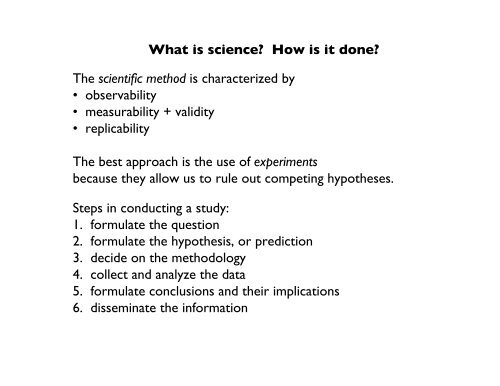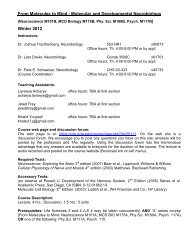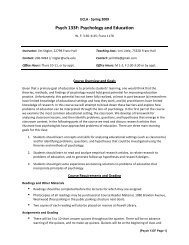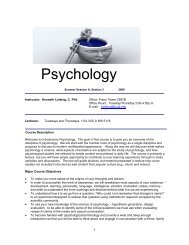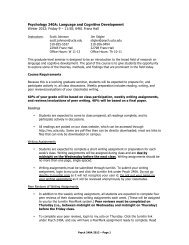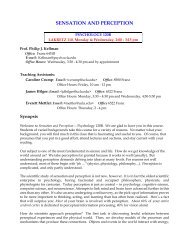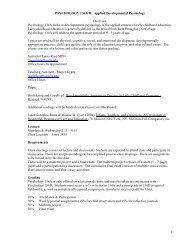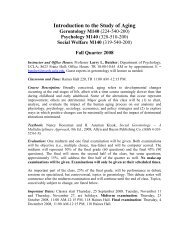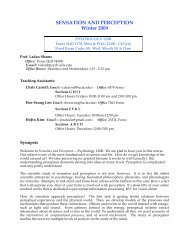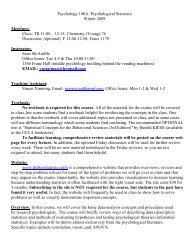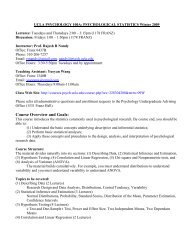What is science? How is it done? The scientific method is ...
What is science? How is it done? The scientific method is ...
What is science? How is it done? The scientific method is ...
You also want an ePaper? Increase the reach of your titles
YUMPU automatically turns print PDFs into web optimized ePapers that Google loves.
<strong>What</strong> <strong>is</strong> <strong>science</strong>? <strong>How</strong> <strong>is</strong> <strong>it</strong> <strong>done</strong>?<br />
<strong>The</strong> <strong>scientific</strong> <strong>method</strong> <strong>is</strong> characterized by<br />
• observabil<strong>it</strong>y<br />
• measurabil<strong>it</strong>y + valid<strong>it</strong>y<br />
• replicabil<strong>it</strong>y<br />
<strong>The</strong> best approach <strong>is</strong> the use of experiments<br />
because they allow us to rule out competing hypotheses.<br />
Steps in conducting a study:<br />
1. formulate the question<br />
2. formulate the hypothes<strong>is</strong>, or prediction<br />
3. decide on the <strong>method</strong>ology<br />
4. collect and analyze the data<br />
5. formulate conclusions and their implications<br />
6. d<strong>is</strong>seminate the information
An example: infant object perception<br />
Step 1. <strong>The</strong> question: <strong>How</strong> do infants make sense of the v<strong>is</strong>ual world?<br />
Step 2. <strong>The</strong> hypothes<strong>is</strong>: Where do we start?<br />
“Gestalt” theory: Why does the world look the way <strong>it</strong> does?<br />
Methods: phenomenology and introspection
organizational principles:<br />
• goodness of form<br />
• continu<strong>it</strong>y<br />
• simplic<strong>it</strong>y<br />
• symmetry<br />
• common fate<br />
• figure/ground<br />
• the whole <strong>is</strong> greater than the sum of the parts<br />
<strong>What</strong> would Gestalt theory predict about infants?<br />
Step 3. <strong>The</strong> <strong>method</strong>: Hab<strong>it</strong>uation/d<strong>is</strong>hab<strong>it</strong>uation<br />
Kellman<br />
& Spelke<br />
(1983):
Step 4. Collect and analyze the data.<br />
chance, randomness, patterns, and stat<strong>is</strong>tics: <strong>is</strong> your iPod conscious?
Step 5. Draw conclusions and implications from the data:<br />
<strong>How</strong> do we know which Gestalt cues infants used to perceive<br />
object un<strong>it</strong>y?<br />
Yes<br />
Yes<br />
Yes<br />
No No No<br />
Conclusions: Were the predictions supported?
Virtually every <strong>scientific</strong> advancement <strong>is</strong> made like th<strong>is</strong><br />
(incrementally).<br />
Step 6. Publication in a journal<br />
<strong>How</strong> objective <strong>is</strong> th<strong>is</strong> process?<br />
Some concepts to draw from th<strong>is</strong> example:<br />
• Cross-sectional vs. long<strong>it</strong>udinal <strong>method</strong>s<br />
• True (controlled) experiments vs. other <strong>method</strong>s<br />
(e.g., correlational studies, case studies, self-reports,<br />
natural<strong>is</strong>tic observations, interviews,<br />
physiological measures, etc.)<br />
• independent + dependent variables, random assignment, etc.<br />
• Sampling<br />
• Ethical considerations
Some of the principals, and their principles…<br />
<strong>The</strong> goal: personal<strong>it</strong>y & psychopathology<br />
<strong>The</strong> starting point: id<br />
Mechan<strong>is</strong>m(s) of development:<br />
• biological drives & drive reduction<br />
• parenting (internalization)<br />
Contributions to developmental psychology:<br />
• emphas<strong>is</strong> on early experience<br />
• interaction<strong>is</strong>t perspective<br />
Freud<br />
Key terms:<br />
• id, ego, superego<br />
• Oedipus complex (Electra for girls)<br />
• oral, anal, phallic, latent, gen<strong>it</strong>al stages<br />
• identification, repression, projection,<br />
compensation, fixation
Some of the principals, and their principles…<br />
<strong>The</strong> goal: lifespan personal<strong>it</strong>y development<br />
<strong>The</strong> starting point: a sense of trust vs. m<strong>is</strong>trust<br />
Mechan<strong>is</strong>m(s) of development:<br />
• cr<strong>is</strong><strong>is</strong> resolution<br />
• parenting in<strong>it</strong>ially, then individual choices<br />
Contributions to developmental psychology:<br />
• a lifespan perspective<br />
• broader than Freudian theory<br />
Erikson<br />
Key terms:<br />
• autonomy vs. shame & guilt<br />
• con<strong>science</strong><br />
• inferior<strong>it</strong>y vs. competence<br />
• sense of ident<strong>it</strong>y
Some of the principals, and their principles…<br />
<strong>The</strong> goal: mental processes<br />
<strong>The</strong> starting point: abil<strong>it</strong>y to learn<br />
Mechan<strong>is</strong>m(s) of development:<br />
• cond<strong>it</strong>ioning (classical)<br />
Contributions to developmental psychology:<br />
• emphas<strong>is</strong> on learning<br />
• theory building<br />
Pavlov<br />
Key terms:<br />
• uncond<strong>it</strong>ioned stimulus >>><br />
uncond<strong>it</strong>ioned response<br />
• cond<strong>it</strong>ioned stimulus >>><br />
cond<strong>it</strong>ioned response
Some of the principals, and their principles…<br />
<strong>The</strong> goal: application of Pavlov’s ideas to humans<br />
<strong>The</strong> starting point: abil<strong>it</strong>y to learn (blank slate)<br />
Mechan<strong>is</strong>m(s) of development:<br />
• cond<strong>it</strong>ioning<br />
Contributions to developmental psychology:<br />
• emphas<strong>is</strong> on behavior<br />
• prec<strong>is</strong>e specification of operationalized<br />
variables and objective measurement<br />
Watson<br />
Key terms:<br />
• Behavior<strong>is</strong>m<br />
• reflexes<br />
• associations<br />
• the famous quote<br />
• L<strong>it</strong>tle Albert
Some of the principals, and their principles…<br />
<strong>The</strong> goal: apply cond<strong>it</strong>ioning to complex behavior<br />
<strong>The</strong> starting point: abil<strong>it</strong>y to learn (blank slate)<br />
Mechan<strong>is</strong>m(s) of development:<br />
• operant (and classical) cond<strong>it</strong>ioning<br />
Contributions to developmental psychology:<br />
• emphas<strong>is</strong> on interaction of individual<br />
w<strong>it</strong>h the environment<br />
• better specification of cond<strong>it</strong>ioning<br />
h<strong>is</strong>tory<br />
Skinner<br />
Key terms:<br />
• reinforcement<br />
• reward<br />
• pun<strong>is</strong>hment<br />
• behavior modification
Some of the principals, and their principles…<br />
<strong>The</strong> goal: learning beyond cond<strong>it</strong>ioning<br />
<strong>The</strong> starting point: several kinds of learning<br />
Mechan<strong>is</strong>m(s) of development:<br />
• observation & im<strong>it</strong>ation<br />
Contributions to developmental psychology:<br />
• emphas<strong>is</strong> on learning that <strong>is</strong> not<br />
reinforced<br />
• consideration of indirect effects of<br />
environmental character<strong>is</strong>tics (e.g., gender<br />
stereotyping)<br />
Bandura<br />
Key terms:<br />
• observational learning<br />
• the Bobo doll study
Some of the principals, and their principles…<br />
<strong>The</strong> goal: an evolutionary approach<br />
<strong>The</strong> starting point: innate instincts<br />
Mechan<strong>is</strong>m(s) of development:<br />
• imprinting<br />
Contributions to developmental psychology:<br />
• emphas<strong>is</strong> on unlearned behaviors<br />
• consideration of evolutionary h<strong>is</strong>tory<br />
Lorenz<br />
Key terms:<br />
• ethology<br />
• cr<strong>it</strong>ical period<br />
• sens<strong>it</strong>ive period<br />
• innateness
A complicated social behavior thought to be biologically mediated: attachment<br />
Factors pred<strong>is</strong>posing attachment of newborn infant to mother:<br />
• bias to look at motion<br />
• bias to attend to sounds in the frequency of the female voice<br />
• early preference for faces<br />
Factors pred<strong>is</strong>posing attachment of mother to newborn infant:<br />
• “motherese”<br />
• response to social smile<br />
• cuteness elic<strong>it</strong>s caregiving behaviors
An aside: what does <strong>it</strong> mean for something to be innate?<br />
• Present at birth vs. later emergence<br />
• Genetic vs. environmental<br />
• Unlearned vs. learned<br />
• Culturally universal vs. culture specific<br />
• Species universal vs. species specific<br />
• Individually universal vs. specific to individuals<br />
• Biological vs. cultural<br />
• Inev<strong>it</strong>able vs. flexible<br />
• Central vs. peripheral<br />
• Modular vs. general-purpose
Genes, environment, & behavior: <strong>What</strong> causes what?<br />
Concordance studies: monozygotic vs. dizygotic twins, family members, & unrelated people<br />
Bouchard & McGue, 1981
OGOD vs. QTL<br />
http://www.ornl.gov/TechResources/Human_Genome/home.html
Genetic determin<strong>is</strong>m = nonsense<br />
enzyme production<br />
regulation of biochemical<br />
reactions in cells<br />
Proteins<br />
Cellular<br />
metabol<strong>is</strong>m<br />
regulation of nervous system,<br />
endocrine system, etc.<br />
Physiological<br />
mechan<strong>is</strong>ms<br />
direct & indirect effects<br />
Genes<br />
Behavior<br />
the “environment”
<strong>How</strong> do we get from th<strong>is</strong><br />
Is the brain a computer?<br />
<strong>How</strong> does <strong>it</strong> work?<br />
to th<strong>is</strong>?<br />
Brain development questions:<br />
1. <strong>How</strong> do neurons develop?<br />
2. <strong>How</strong> do they know where to go?<br />
3. <strong>How</strong> do they know how to interconnect?<br />
4. <strong>How</strong> do they know what to do?
Brain basics: I<br />
Neurons & networks<br />
Brain development phenomena:<br />
1. Neurogenes<strong>is</strong> & connectiv<strong>it</strong>y<br />
2. Synaptogenes<strong>is</strong><br />
3. Synaptic pruning<br />
4. Myelination
Brain basics: II<br />
areal specific<strong>it</strong>y<br />
Is the cortex equipotential?<br />
Brodmann’s areas
Brain basics: III<br />
laminar specific<strong>it</strong>y
Origins of neurons
Development of connectiv<strong>it</strong>y: the radial un<strong>it</strong> hypothes<strong>is</strong> (Rakic)<br />
abbreviations:<br />
MZ = marginal zone<br />
CP = cortical plate<br />
SP = subplate zone<br />
IZ = interzone<br />
VZ = ventricular zone<br />
E = embryonic day of<br />
development<br />
RG = radial glial cell<br />
MN = migrating neuron<br />
CC = corpus callosum<br />
TR = thalamic radiations
Input from sensory systems<br />
guides brain development<br />
Molecular markers<br />
guide neural migration<br />
LGN = lateral geniculate nucleus<br />
MGN = medial geniculate nucleus
Transplant studies: evidence for equipotential<strong>it</strong>y
Synaptogenes<strong>is</strong> & synaptic pruning<br />
corpus<br />
callosum<br />
cortex
Continu<strong>it</strong>y across prenatal & postnatal development: sleep patterns
Experience & development<br />
Molyneux’s question: "Suppose a man born blind, and<br />
now adult, and taught by h<strong>is</strong> touch to d<strong>is</strong>tingu<strong>is</strong>h<br />
between a cube and a sphere of the same metal, and<br />
nighly of the same bigness, so as to tell when he felt<br />
one and the other, which <strong>is</strong> the cube, which <strong>is</strong> the<br />
sphere. Suppose then the cube and the sphere placed<br />
on the table, and the blind man made to see; query:<br />
whether by h<strong>is</strong> sight, before he touched them, he could<br />
d<strong>is</strong>tingu<strong>is</strong>h and tell which <strong>is</strong> the globe, which <strong>is</strong> the<br />
cube?"
MM’s v<strong>is</strong>ual proficiency (Fine et al., 2003)
MM’s v<strong>is</strong>ual proficiency (Fine et al., 2003)
Orientation sens<strong>it</strong>iv<strong>it</strong>y in k<strong>it</strong>tens (Blakemore & Cooper, 1970):
Direction sens<strong>it</strong>iv<strong>it</strong>y in k<strong>it</strong>tens<br />
(Cynader & Chernenko, 1976):<br />
Ocular dominance and stereoblindness<br />
(Crawford et al., 1992): Pr<strong>is</strong>ms and diplopia<br />
in infant monkeys
V<strong>is</strong>ual deprivation and face perception in humans (Le Grand et al., 2001):
V<strong>is</strong>ual deprivation and face perception in humans (Le Grand et al., 2001):
V<strong>is</strong>ual deprivation and face perception in humans (Le Grand et al., 2001):
Plastic<strong>it</strong>y throughout the lifespan in cortical reorganization: phantom limbs<br />
(Ramachandran & Hirstein, 1998):
Perceptual development<br />
1. <strong>How</strong> do we parse the input?<br />
2. <strong>How</strong> do we make sense of the input?<br />
A description of the problem to be solved:<br />
<strong>The</strong> optic array (J. J. Gibson)
aerial perspective<br />
Pictorial information for d<strong>is</strong>tance<br />
relative & familiar size<br />
height in the picture plane<br />
T-junctions<br />
(interpos<strong>it</strong>ion)<br />
linear perspective<br />
texture gradients<br />
transparency<br />
shading<br />
shadows
Motion information for d<strong>is</strong>tance<br />
Degree of<br />
relative<br />
motion<br />
Observer motion<br />
Optic flow<br />
Motion parallax
Motion information for d<strong>is</strong>tance<br />
Kinetic occlusion
Stereoscopic (binocular) information for d<strong>is</strong>tance
Investigating development of depth perception<br />
the “v<strong>is</strong>ual cliff”
Perceiving depth from pictorial information (Yonas)
Development of object perception: un<strong>it</strong>y (Johnson)
Development of object perception: segregation (Needham)
Development of v<strong>is</strong>ual attention<br />
" "<br />
fovea<br />
(1-2°)<br />
Eye<br />
lens<br />
Optic nerve<br />
foveation<br />
Why <strong>is</strong> foveation necessary?
Eye movement types:<br />
1. Saccades<br />
2. Smooth pursu<strong>it</strong><br />
3. Optokinetic nystagmus<br />
4. Vestibulo-ocular reflex<br />
5. Convergence<br />
<strong>How</strong> do infants know where to look?<br />
Development of saccades<br />
(Johnson & Johnson, 2000):<br />
2-month-old<br />
4-month-old
Eye movement types:<br />
1. Saccades<br />
2. Smooth pursu<strong>it</strong><br />
3. Optokinetic nystagmus<br />
4. Vestibulo-ocular reflex<br />
5. Convergence<br />
Recording smooth pursu<strong>it</strong> in infants
Eye movement types:<br />
1. Saccades<br />
2. Smooth pursu<strong>it</strong><br />
3. Optokinetic nystagmus<br />
4. Vestibulo-ocular reflex<br />
5. Convergence<br />
Development of smooth pursu<strong>it</strong> (Aslin, 1981):<br />
Development of saccades<br />
(Johnson & Johnson, 2000):<br />
2-month-old<br />
4-month-old
V<strong>is</strong>ual development as a model system for cortical development<br />
Felleman and Van Essen (1991)
Schiller’s (1985) model:<br />
Mark Johnson’s (1990) model:<br />
neonate<br />
2- to 4-month-old
Cogn<strong>it</strong>ive development: Piaget’s theory<br />
It’s a stage theory:<br />
• qual<strong>it</strong>ative differences between stages<br />
• invariant sequence<br />
• early structures --> later stages<br />
• internal coherence of stages<br />
• periods of trans<strong>it</strong>ion: d<strong>is</strong>equilibrium<br />
Jean Piaget (1896-1980)<br />
• décalages are a challenge to the theory<br />
It’s a constructiv<strong>is</strong>t theory<br />
It’s an interaction<strong>is</strong>t theory
“Genetic ep<strong>is</strong>temology:” focus on<br />
• intelligence<br />
• adaptation<br />
• organization<br />
• assimilation & accommodation
Methods:<br />
• interviews<br />
• observations<br />
Periods of development:<br />
• sensorimotor<br />
• preoperational<br />
• concrete operational<br />
• formal operational
<strong>The</strong> sensorimotor period: development of mental representations and<br />
trans<strong>it</strong>ion from egocentric to allocentric spatial reasoning<br />
Stages 1-2: in<strong>it</strong>ially “out of sight, out of mind,” then recogn<strong>it</strong>ion memory<br />
Stage 3: beginnings of active search. For example:<br />
• reconstruction of an inv<strong>is</strong>ible whole from a v<strong>is</strong>ible fraction<br />
• v<strong>is</strong>ual accommodation to rapid movements<br />
• removal of obstacles preventing perception<br />
Stage 4: perseverative (A not B) error<br />
Stage 5: multiple v<strong>is</strong>ible d<strong>is</strong>placements<br />
Stage 6: full object permanence
Stage 3: early object concepts<br />
Reconstruction of an inv<strong>is</strong>ible whole<br />
V<strong>is</strong>ual accommodation to rapid movements<br />
Stages 4-6: trans<strong>it</strong>ion to mature object concepts<br />
Experimenter<br />
A<br />
B<br />
Infant
Success at the A not B task depends on:<br />
• age<br />
• delay between hiding and search<br />
Experimenter<br />
A<br />
B<br />
• d<strong>is</strong>tinctiveness of hiding locations<br />
Infant<br />
• d<strong>is</strong>tance between hiding locations,<br />
and presence of other hiding locations<br />
• brain maturation (Adele Diamond)<br />
A<br />
Experimenter<br />
Infant<br />
B<br />
• search h<strong>is</strong>tory (Linda Sm<strong>it</strong>h, Esther <strong>The</strong>len)
<strong>The</strong> preoperational and concrete operational periods:<br />
<strong>The</strong> trans<strong>it</strong>ion to logical thinking<br />
In<strong>it</strong>ial difficulties:<br />
• egocentr<strong>is</strong>m<br />
experimenter<br />
child<br />
ego view
• centration<br />
Number<br />
Conservation<br />
tasks
Cogn<strong>it</strong>ive development: Information-processing theory<br />
Contrasts w<strong>it</strong>h Piagetian theory:<br />
• continuous development, rather than stagelike<br />
• focus <strong>is</strong> on process, not product<br />
• careful consideration of task character<strong>is</strong>tics
An example: memory<br />
<strong>What</strong> determines whether something <strong>is</strong> remembered?<br />
Response<br />
motor control<br />
motivation<br />
All-pervasive:<br />
Input<br />
Sense<br />
organ<br />
attention<br />
motivation<br />
receptor matur<strong>it</strong>y<br />
Iconic<br />
storage<br />
Production<br />
Short-term<br />
(working)<br />
memory<br />
retrieval<br />
Long-term<br />
memory<br />
matur<strong>it</strong>y of<br />
neurophysiological<br />
structures<br />
rehearsal &<br />
practice<br />
task interference<br />
encoding<br />
consolidation<br />
knowledge base<br />
strategy use
<strong>What</strong> changes? I: <strong>The</strong> brain
<strong>What</strong> changes? II: Basic cogn<strong>it</strong>ive function
<strong>What</strong> changes? III: Strategy use
Add<strong>it</strong>ion strategies (Siegler)
Locomotion strategies (Adolph)
<strong>What</strong> changes? IV: General knowledge<br />
For example:<br />
• scripts, other content domains<br />
• metamemory<br />
• planning<br />
• analogical reasoning
Cogn<strong>it</strong>ive development: Core knowledge theory<br />
Defining character<strong>is</strong>tics:<br />
• focus on areas important to human survival (evolutionary theory)<br />
(e.g., object perception, face perception, understanding others, language)<br />
• domain specific<strong>it</strong>y<br />
• genes create a tool for each job<br />
speech perception<br />
theory of mind<br />
language<br />
memory<br />
attachment<br />
face perception<br />
object perception
Cogn<strong>it</strong>ive development: Sociocultural theories<br />
Principles:<br />
• children are inherently social creatures shaped by culture & context<br />
• cogn<strong>it</strong>ive development relies on culturally-defined systems<br />
(e.g., language, wr<strong>it</strong>ing, mathematics, moral values)<br />
• cogn<strong>it</strong>ive development <strong>is</strong> guided by adults and peers<br />
A mental activ<strong>it</strong>y appears “on two planes.<br />
It appears first between people as an<br />
intermental category, and then w<strong>it</strong>hin the<br />
child as an intramental category.” (<strong>it</strong>alics<br />
added)<br />
Lev Vygotsky (1896-1934)
<strong>The</strong> zone of proximal development “<strong>is</strong> the d<strong>is</strong>tance between the actual developmental level as<br />
determined by independent problem solving and the level of potential development as<br />
determined through problem solving under adult guidance or in collaboration w<strong>it</strong>h more<br />
capable peers.” (Vygotsky, 1935)<br />
potential level<br />
actual level<br />
ZPD
Vygotsky vs. Piaget<br />
Focus on individual and<br />
cultural differences<br />
Cogn<strong>it</strong>ive development driven by<br />
sociocultural interaction:<br />
• instruction dependent<br />
• guided by others<br />
Focus on cogn<strong>it</strong>ive universals<br />
Cogn<strong>it</strong>ive development driven by<br />
individual construction:<br />
• stage dependent<br />
• experimentation<br />
Thought = language (Whorf)<br />
• once language develops,<br />
thought <strong>is</strong> lingu<strong>is</strong>tically mediated<br />
Thought <strong>is</strong> independent of language<br />
• cogn<strong>it</strong>ion precedes language<br />
• language <strong>is</strong> a subset of cogn<strong>it</strong>ive skills


